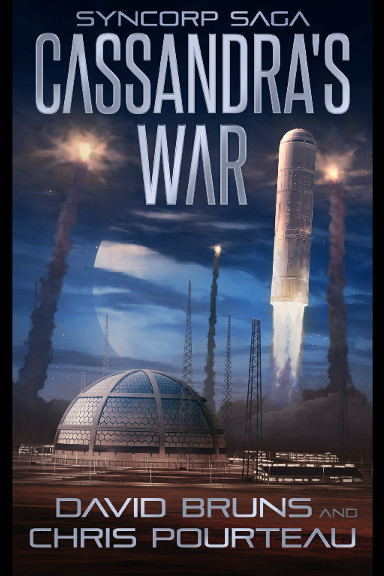
The novel “Cassandra’s War” by David Bruns and Chris Pourteau was published for the first time in 2018. It’s the second book in The SynCorp Saga series and follows “The Lazarus Protocol“.
Both Anthony Taulke and Ming Qinlao find themselves in complex situations that force them to rather extreme measures, sometimes relying on the help of someone else. Their paths cross again but are their agendas still compatible?
Luca Vasquez is working on an animal experiment that gives unexpected results and what lies behind it is about to lead to the death of all the guinea pigs. Luca wants to save them and what she discovered piques the interest of General William Graves, who has just obtained a promotion to receive an important assignment. Their paths also cross with that of Remy Cade, who has to make difficult decisions about the woman he loves.
“The Lazarus Protocol” started a saga set in a future in which the environmental situation has become critical with heavy consequences also on the inhabitants of rich countries. Radical plans, sabotage, deception, and much more created a really difficult situation at the end of the novel, which must be read to understand the protagonists who return in “Cassandra’s War” and the events, which are the direct continuation of the ones of the first novel.
The mysterious organization behind espionage and sabotage operations already started revealing its plans for the future. In “Cassandra’s War” the authors offer a lot of information about it that make some of the twists of this novel. The work carried out by Luca Vasquez, a new addition to the first novel’s protagonists, contributes to those revelations.
In “Cassandra’s War” it’s in some ways easier to understand the developments of the various subplots than in “The Lazarus Protocol” because the protagonists have already started meeting and interacting during the first novel. In this sequel, the writers can focus on various plot and character developments while keeping the pace fast.
The characters and the elements of the plot are not exactly original but the authors show again in this sequel that they can mix them in non-obvious ways. The consequence is that those developments can be unpredictable with surprises that make sense and are well used to move the various subplots forward.
“Cassandra’s War” continues the good things seen in “The Lazarus Protocol” with certain political and economic interests that remain a priority despite the increasingly serious environmental problems. The events of the first novel led to a crisis, yet power struggles seem far more important than finding solutions to problems that distress ordinary people.
The projection into the future of the current situation remains important after being one of the initial premises. However, in “Cassandra’s War” the developments of the science fiction elements in the reasons of crisis and instability have a great strength that offers the possibility to continue them in the rest of this series with various ramifications.
“Cassandra’s War” ends with some important events open to further developments that will come in its sequels. This series continues to have a compelling story while offering some food for thought. If you’re ready to read a whole series with these themes, I recommend reading it, especially if you like novels that are not very long.

